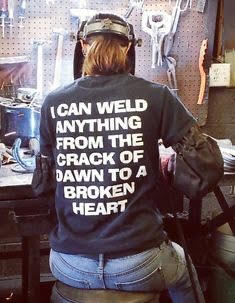If you have had your heart broken you’ll know there is no way to repair it; however, fortunately for us fabricators we do not have to weld broken hearts. If you have been out in the field at least a few times you are probably familiar with the saying “I can weld anything from the crack of dawn to a broken heart.” This is supposed to be funny, but the truth is that many of us have that attitude. Give me anything and I’ll find way to weld it!
We build amazing things like skyscrapers and pressure vessels for nuclear power plants. We can even weld carbon steel to aluminum (not by arc welding). We create some of the most amazing things in this world so naturally we believe that we can weld anything. So we can’t weld a broken heart, but we can certainly weld many things.
There is danger in having this can-do attitude of “I can weld anything” especially if we do not fully understand the metal we are trying to weld. Most fabricator that weld specialty metals that are prone to cracking or have other weldability issues typically have the benefit of knowing exactly what they are welding on. They know the chemistry and can determine the effects of heat input, filler metal chemistry and other welding variables on the final weldment. But what happens when structures welded with these not-so-common alloys developed cracks and have to be repaired?
Many times a maintenance crew is brought in. They may or may not know what the base material is. They end up making educated guesses as to the alloy based on the application (what the structure is used for). They may use filler metals for welding dissimilar alloys in order to play it safe. This guessing game can result in a big problem if we don’t understand what we are welding on.
If you have to weld on a structure or part you must know the base metal. If you don’t, this list may be helpful:
- Ask the owner of structure – the owner of the structure is probably not the fabricator that built it, so they may not know that identify the metal used is important. You need to ask them. If they don’t know tell them to find out. Unfortunately, there are time when you will not get an answer and you need to look at alternatives.
- You can remove a section of the base metal and send to a lab to determine the exact chemistry. This is a very safe approach and you will get all the information you need. However, it is not always feasible to remove a section of the structure.
- Use a handheld spectrometer to analyze the metal. These devices can be accurate but many not capture all the elements. However, it can help you identify elements that could be extremely problematic and develop a procedure with that in mind.
- You can also use a grinding wheel on the structure and the pattern of the sparks can let you know if there is a lot of carbon – this is only good on carbon steel but it can alert you to the possibility of a high carbon steel which may need to be preheated or welded with higher strength filler metals.
- If all else fails you can always try to use a stainless filler metal. Weld only a small section and perform visual inspection. It may be necessary to use dye penetrant testing to ensure there are no surface cracks. Some specialty alloys are susceptible to solidification cracking, but the initial crack may be small and we may miss it if we only inspect with the naked eye.
Regardless of what you have to weld, always make sure you know the base metal. Make it a habit to ask questions of your customers. If they don’t know ask them to find out.
The takeaway from this article is simple: If you don’t know what it is don’t try to weld it. Find out what you are dealing with.


Please note: I reserve the right to delete comments that are offensive or off-topic.